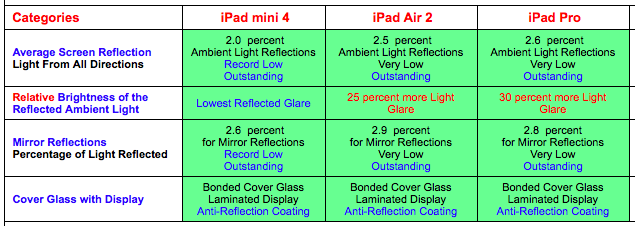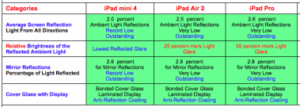Apple’s newest crop of tablets including the iPad Mini4, iPad Air2 and brand new flagship tablet from Apple, the iPad Pro gained “unrivaled record holder” performance status in ambient light conditions, mostly due to their “significantly lower” reflectance numbers when compared to rival tablets currently shipping in the industry. This, according to Dr. Ray Soneira and his DisplayMate Technologies recent Shoot-out battery of display test results released today.

By the numbers, the new Apple tablet screen reflectance ranging from 2.0% to 2.6%, beats the 4.5% to 6.5% reflectance found in all other current competing Tablets. Soneira said its iPad mini4 is the best at 2.0%, with the Apple iPad Air2 at 2.5% and the iPad Pro up a decimal point at 2.6%.
 Apple scored record low screen reflectance in its latest crop of iPad mobile tablets according to DisplayMate Technologies, Source: DisplayMate
Apple scored record low screen reflectance in its latest crop of iPad mobile tablets according to DisplayMate Technologies, Source: DisplayMate
Regarding Screen Reflectance
In the past, Soneira has jokingly characterized mobile device display screens viewed outdoors as good enough to serve as “Cosmetic Mirrors” noting that they reflect light from everything that is illuminated anywhere in front of the screen (especially anything behind the viewers), “…which washes out the on-screen colors, degrades image contrast, and interferes with seeing the on-screen images,” he wrote in his recent Display Industry Shoot-Out that focused on Apple’s top iPad offerings. According to Soneira, a 50% reduction in screen reflectance like that demonstrated in the new Apple iPads essentially doubles the “effective contrast ratio in ambient light, so this is very important.”
 Apple’s decision to use a metal oxide TFT backplane gives its new iPad Pro a relative power efficiency boost over the much smaller iPad mini4, Source: DisplayMateJust how important is underscored by the DisplayMate qualitative measure for contrast under high ambient light, meant to measure the all important screen visibility under bright (daylight conditions.) Here, the low reflectance and high brightness in the iPad Mini 4 delivered off the charts performance with a 225:1 rating, “…by far the highest that we have ever measured,” according to the Soneira Shoot-out write-up. The iPad Air2 and the iPad Pro have 166:1 and 163:1 contrast ratio, respectively.
Apple’s decision to use a metal oxide TFT backplane gives its new iPad Pro a relative power efficiency boost over the much smaller iPad mini4, Source: DisplayMateJust how important is underscored by the DisplayMate qualitative measure for contrast under high ambient light, meant to measure the all important screen visibility under bright (daylight conditions.) Here, the low reflectance and high brightness in the iPad Mini 4 delivered off the charts performance with a 225:1 rating, “…by far the highest that we have ever measured,” according to the Soneira Shoot-out write-up. The iPad Air2 and the iPad Pro have 166:1 and 163:1 contrast ratio, respectively.
Soneira also notes that some significant changes were introduced to the displays in the two larger tablets from Apple. For one, both the iPad Air2 and iPad Pro use a Photo Aligned LCD rather than the mechanical alignment found on the iPad Mini 4. This delivers higher contrast ratio numbers according to DisplayMate testing. Also, for the flagship iPad Pro, Apple opted to use a Metal Oxide TFT backplane that helps boost light transmissivity, with a ripple effect that leads to improved power efficiency, critical for the larger LCD panel devices. To get an idea of just how effective a metal oxide backplane can be, the much larger 12.9-inch diagonal iPad Pro display screen returned a relative power efficiency score of 133%, better than the much smaller 7.9-inch iPad Mini 4 rated at 122% efficiency over the benchmark iPad Air2 (rated at 100%) with its 9.7-inch diagonal display.
Soneira said common features of all the new tablet displays include 4:3 (h v) screen ratio, IPS (in plane switching) LCD panels, plus all three are considered “Retina-class” Displays, with individual pixels beyond human visual acuity resolution at typical viewing distances. Speaking of pixels, the Pixels Per Inch (PPI) rating is a whopping 326 PPI for the smaller iPad Mini 4 (with 2048 x 1536 pixels), and 264 PPI for both the iPad Air 2 (2048 x 1536 pixels) and iPad Pro with its 2732 x 2048 pixels and delivering a 3x screen area over its smaller (Mini 4) cousin. Be sure to click through for the full details and extensive write-up from the good Doctor. It’s well worth the read.
We see the Apple next gen tablets as demonstrating the company’s commitment to display performance improvements, racking up “off the chart” numbers in the all important high ambient screen readability category, as well as promising power efficiency improvements. This was done by improving screen reflectance and other upgrades like metal oxide TFT backplane technology used in the iPad Pro line. We are truly in the golden age of mobile display technology with better displays certain to come, as the bar has just been moved yet again. Steve Sechrist

